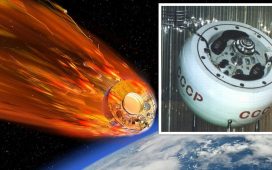Wildfires across the U.S. and around the world are becoming more frequent, costly, and dangerous. Early detection of ignition increases the likelihood of timely containment and suppression of wildfires, saving lives and reducing property losses.
Wildfire sensors research focuses upon real-time and continuous identification of elements found in wildfire conditions, including particulate matter, volatile organic compounds, chemicals, and gases to detect ignition location, allowing for geographically targeted notifications and warnings.
S&T began efforts at developing wildfire sensors in late 2019 by researching literature from federal, state, and academic authorities to learn about wildfire characteristics. Available fire sensors at the time were optical cameras or thermal imaging—they would “see” the fires. But have you ever known there was a fire nearby, whether a campfire or a grill or brush, because you could smell the smoke before you saw flames? That’s what our sensors program is aiming to do—“sniff” out the fires as soon as they start, providing 24-hour sensing and alerting capabilities.
The wildfire sensor acts like a sensitive nose for gases and tiny solid particles in the air—these are signs of fire ignition. It “sniffs,” taking measurement data and sending it to the cloud every 18 seconds. A robust artificial intelligence (AI) enabled cloud-based system analyzes the data and compares it to the established baseline—wildfire sensors are “learning” sensors, they will gather data to establish a baseline for its location. After the analysis is complete, the system notifies the end user via a dashboard accessible on both desktop and smartphone. If a fire is detected, an alert is sent via text message and displayed in the dashboard. The addition of rapid, geographically targeted alerts, warnings, and notifications could prove the difference between a localized fire response and a large-scale tragedy.
While conducting research, S&T examined factors that included gas levels, humidity, environmental conditions, temperatures, and particulate levels. One of the deadliest aspects of fires are the different particulates that wildfires generate, with 2.5 parts per million (ppm) being the most common and deadliest, causing respiratory problems. These new sensors can detect gases and particulate levels that are about 1,000 times more sensitive than a home smoke alarm—while this is great for detection, it could also result in possible false positives, making the AI algorithms even more important to sensor wildfire detection.
S&T then modeled a historic wildfire to understand the level of concentrations of smoke composition, particulate matter, and dispersion at varying distances and wind conditions. This helped validate assumptions S&T had made from our research on how to best distribute sensors.
Sniffing for Wildfires
In 2021, S&T participated in an interagency test and demonstration of prototype sensors from multiple small business partners on about 1,000 acres in Northern California over two days. The sensors collected data and detected ignitions over time at a distance ranging from one to five miles.
In 2023, two small business partners deployed a total of 200 alpha wildfire sensors in various locations in the U.S. and Canada. One of the alpha sensors field-tested in Colorado identified a reignition at a controlled burn site and generated an alert that was passed along to the county office of emergency management. The alert gave the agency a significant 37-minute head start prior to the first 911 call, allowing for a much faster emergency response. Overall, the alpha sensors collected over 1,000,000 hours of data in the field, which was used to enhance the artificial intelligence (AI) learning algorithms now used in the updated beta sensors.
Throughout 2024, S&T and a small business partner, N5 Sensors Inc., in collaboration with the U.S. Fire Administration, will deploy approximately 200 beta wildfire sensors for operational test and evaluation with fire community stakeholders. Because they are “learning” sensors, they will gather data to establish a baseline for its location. The beta wildfire sensors will be able to notice unusual concentrations or spikes in particulates or carbon monoxide, that are unusual for the area based on its past data collection.
The new beta version wildfire sensors will also include:
- Improved ability to operate in areas with limited cellular connectivity, with enhanced alert and warning notifications;
- Reduced power consumption for longer run times between recharge cycles; and
- Integrated wind sensors that replace third party wind data, increasing accuracy of wildfire location prediction.
The inaugural beta deployment will be in Hawaii. Working with partners such as the Hawaiian fire chiefs and state and local officials, S&T plans on deploying 80 wildfire sensors and 16 wind sensors across the Hawaiian Islands. These sensors will collect data that can further refine how the final sensors perform, while also detecting anomalies that may indicate a fire. Through partnership with the Hawaii fire chiefs and stakeholders at the state and local levels, the team will test and evaluate the sensors in ways that will have national benefit beyond the shores of Hawaii.
Additional planned 2024 beta test locations include California, Colorado, Tennessee, Arizona, and Canada.
Alerting agencies to early ignitions is critical to successful emergency prevention, response, and recovery efforts, both for communities and public safety. A network of intelligent sensors allows first responders to get to the source of ignition sooner to suppress an initial blaze before it spreads out of control. Advanced notice of an imminent fire hazard could also grant time needed for communities to make life-saving evacuation decisions.
Through continued R&D in wildfire sensing capabilities, S&T and USFA aim to help communities detect and respond to wildfire emergencies more efficiently for a safer and more resilient homeland.
Wildfires present a significant threat to the United States, and S&T is fighting fire with technology. Wildfire sensor technology could provide the public with the advanced notice necessary to reduce the loss of life and property, while giving communities the information and time necessary to make life saving evacuation.
S&T has engaged in a novel research approach, as opposed to more traditional methods where sensors use optical (visible/near-infrared spectrum) to identify existing wildfires burning. The S&T sensors detect elements found in wildfire conditions, including particulate matter microns (PM2.5, PM5.0, and PM10) and environmental air quality conditions and gases (e.g., temperature, humidity, NOx, SOx, and O3). AI algorithms are used to compare ambient background conditions against wildfire elements to provide warnings if levels are elevated and alerts if spikes of concentrations are detected. Internal batteries are recharged through solar panel energy harvesting with LTE cellular network communications. A web portal and graphical user interface allow stakeholders to review sensor performance, download data, and receive text and email notifications for the warnings and alerts.










